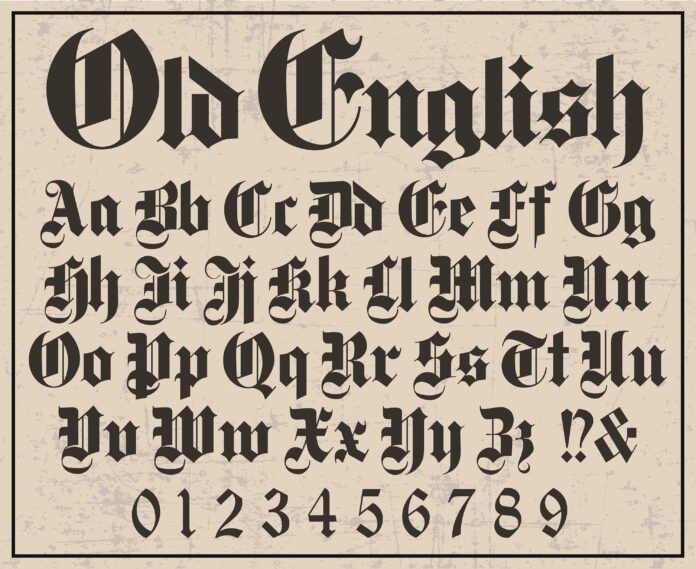Introduction
The Old English font, also known as Blackletter, is a style of typeface that evokes a sense of history, tradition, and timelessness. This font, characterized by its ornate and elaborate design, has been a staple in various forms of media for centuries. From ancient manuscripts to modern tattoos, the Old English font continues to capture the imagination of designers, typographers, and enthusiasts alike.
The Origins of Old English Font
The Birth of Blackletter
The Old English font traces its roots back to the 12th century in Western Europe. Known as Blackletter or Gothic script, this typeface was developed during the medieval period and became the standard script for writing in various European countries.
The Role of Monastic Scribes
Monastic scribes played a crucial role in popularizing the Old English font. They meticulously copied religious texts, using Blackletter to ensure clarity and readability. The font’s dense and compact nature made it ideal for writing lengthy manuscripts, allowing scribes to fit more text onto a single page.
The Evolution of Old English Font
The Printing Revolution
The invention of the printing press in the 15th century marked a significant turning point for the Old English font. Johannes Gutenberg, the pioneer of the printing press, used a variant of Blackletter known as Textura in his famous Gutenberg Bible. This font choice helped preserve the traditional look of manuscripts while making books more accessible to the public.
Transition to Modern Fonts
As the Renaissance era dawned, there was a shift in preference towards more legible and humanistic typefaces. Such as Roman and Italic fonts. These fonts, inspired by classical antiquity, gradually replaced Blackletter in most printed materials.
Revival in the 19th and 20th Centuries
The 19th and 20th centuries saw a revival of interest in Old English font, particularly in the realms of art, design, and advertising. It became a popular choice for branding, logos, and signage, especially in industries that wanted to convey a sense of heritage and trustworthiness.
Contemporary Uses of Old English Font
Graphic Design and Branding
Today, the Old English font is widely used in graphic design and branding. Its distinctive appearance makes it a popular choice for logos, particularly in industries such as fashion, music, and alcohol brands. The font’s ornate and formal look can convey a sense of luxury and exclusivity, making it an ideal choice for high-end brands.
Tattoos and Personal Expression
Old English font has also found a place in the world of body art. The bold and striking design of Old English letters makes them a popular choice for name tattoos, memorials, and religious inscriptions.
Popular Culture and Media
In popular culture, Old English font is frequently used to evoke a sense of history and tradition. It can be seen in the titles of movies, television shows, and video games that are set in historical or medieval periods. The font’s association with the past adds an extra layer of authenticity and immersion to these media.
Digital and Web Design
Despite its historical roots, Old English font has also made its way into the digital world. Web designers and developers use it sparingly to add a touch of elegance and sophistication to websites. When used in headlines or logos, the font can create a striking contrast with more modern and minimalist typefaces, making it stand out on the page.
The Challenges of Using Old English Font
Readability Concerns
One of the primary challenges of using Old English font is its readability. The intricate design and dense letterforms can make it difficult to read, especially in long blocks of text. To mitigate this issue, designers often use the font for headings, logos, or short phrases, while opting for more legible fonts for body text.
Cultural and Historical Associations
Another consideration when using Old English font is its cultural and historical associations. The font is often linked to medieval Europe, religious texts, and certain subcultures. Designers should be mindful of these associations and ensure that the font aligns with the intended message and audience of their project.

Conclusion
The Old English font is a testament to the enduring appeal of historical design. From its origins in medieval Europe to its contemporary uses in branding, tattoos, and digital media, this font continues to captivate and inspire. While it presents certain challenges in terms of readability and cultural associations, its timeless elegance and rich history make it a valuable tool in the hands of skilled designers. Whether you’re creating a logo, designing a website, or expressing your style, the Old English font offers a unique way to connect with the past while making a bold statement in the present.



